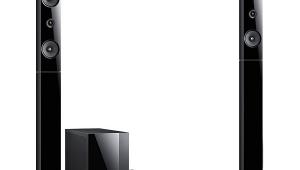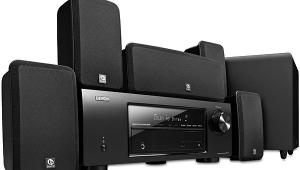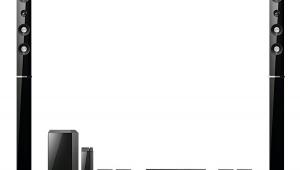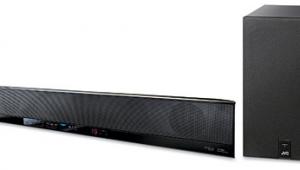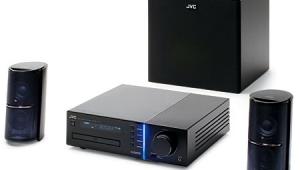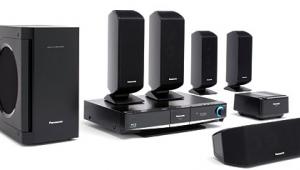B&W Panorama Soundbar Speaker Page 2
While you can use the Panorama out of the box, B&W includes various options if you’re willing to operate menus via the remote control and front-panel display. The sound menu includes bass, treble, bass EQ (for wall or table placement), external sub level, and sub distance. There’s also a room menu that has three presets and a custom setting. Each of these encompasses three other settings: the distance of the soundbar from the seating position, the offset of the speaker’s center from the seating position’s center, and the three wall positions (soft, medium, hard) that affect the way the sides of the soundbar reflect surround effects off the walls. Other adjustments include analog-input gain, lip-sync delay, language, units, and display. The latter can be brightened or turned off. As with any speaker you place close to a screen, it’s helpful to be able to turn off the front-panel display, especially when it’s big and red.
Associated equipment for this review included a Panasonic DMP-BD55 Blu-ray player, which I used for BD, DVD, and CD. I used an optical connection on everything except the third movie selection.
Solid Gold Bar
Solidity is the Panorama’s strong suit. When provided with substantial amounts of bass information, the built-in sub drivers produced low-frequency apocalypse. The thundering wind effects of The Day the Earth Stood Still (DVD, Dolby Digital) practically pinned my ears back. There was a suggestion of directional activity from helicopters. My asymmetrical long-wall placement may have left the soundbar’s surround-producing mechanism at a disadvantage. However, there was discernibly more surround presence in the bar’s Surround mode than when I switched to the Stereo or Stereo-Wide modes. In the switching process—something I did a lot of throughout the review—I noticed that the oval remote worked best when I aimed it on axis and tilted it slightly downward. This probably indicates that the infrared emitter is in the top surface.
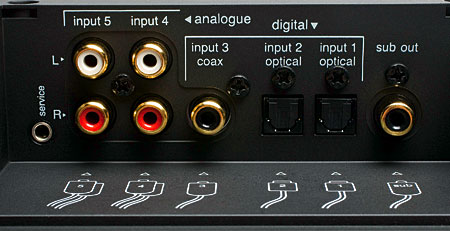
In an emotionally intricate drama like Lake City (DVD, Dolby Digital), with Sissy Spacek as the rural mother of a troubled son, vocal clarity is key. The Panorama was impressive in this regard, with virtually no intelligibility shift as I ranged around the sofa. The soundfield was also impressively stable, with no synthetic-sounding nonsense going on as I changed positions. In the opening song, the rhythm section was nice and tight, and Lucinda Williams’ distressed-leather voice was well focused and affecting. When someone pounded on a door, the bam bam bam once again reminded me of the Panorama’s prowess with the impact and tuning of bass effects.
I wandered off B&W’s chosen path with Pineapple Express. I used the Blu-ray release’s Dolby TrueHD soundtrack, with the player’s stereo analog downmix output going into the soundbar’s analog input and using the speaker’s Dolby Pro Logic II surround processing. In this case, the theoretically increased transparency of Dolby TrueHD made little difference. However, it was obvious that the soundbar had less directional information to work with in the absence of discrete surrounds. The raucous stoner-buddy comedy follows the conventions of the genre, with James Franco as the stupid one and Seth Rogen as the slightly less stupid one. As they got into three-way shout-fests with other intoxicated characters, the Panorama kept up with the vocal chaos. And when a fight scene threw someone down on a collapsing coffee table, the thump reminded me yet again how well this speaker handles bass.
 Three Modes of Pleasure
Three Modes of Pleasure
For music, there really wasn’t a bad choice among the three modes—DPLII Surround, Stereo-Wide, and Stereo. In the live half of Pink Floyd’s Ummagumma CD, the Stereo-Wide mode emphasized the interplay between Rick Wright’s organ and David Gilmour’s guitar. Both are very spacey on this album, and each is as distinctive as a fingerprint. Even in Wright’s most ethereal moments, which include some of his best playing ever, the Panorama’s low-level resolution held my attention. But the rhythm section fared best in the DPLII Surround mode, which supported the powerful drum sound best among the three modes. Even when I upped the bass control in Stereo and Stereo-Wide, DPLII Surround still had the strongest kick drum. The downside of using the DPLII Surround mode is that it’s based on Dolby Pro Logic II’s Movie mode and therefore pushed much of the front soundstage toward the center.
The tradeoff between bass and width continued with the Paul Galbraith Plays Haydn CD. Galbraith’s classical guitar is a unique eight-stringed instrument with a long cello-like pin that rests on a wooden resonating box that sits between the guitarist’s feet. It has more bass than any acoustic guitar I’ve ever heard. At first, I preferred hearing it through the weightier DPLII Surround mode. But in the end, I came to prefer the Stereo-Wide mode, which was spatially superior for the guitar’s midrange—a little better than straight stereo and much better than movie-oriented surround. Haydn probably would have been pleased to hear his keyboard sonatas so cleverly transcribed (with changes in key) and so beautifully played on such an extraordinary instrument.
I couldn’t have hoped for a better variety of vocal performances than I got from a compilation called Carnegie Hall Presents: Lift Every Voice (Honoring the African American Musical Legacy). The singers, who were recorded from 1946 to 2005, demonstrated 20 different ways to access beauty and emotion on this two-CD set from Sony Classical. The big surprise was that even mono recordings benefited from the DPLII Surround mode. It did the best job of delivering Paul Robeson’s rich baritone in “Ol’ Man River.” It not only supported his considerable bottom octave, but it also brought out midrange details of vocal timbre and Carnegie’s familiar concert-hall ambience. In modern stereo recordings where the soundstage mattered more, such as “On Children” performed by Sweet Honey in the Rock, the Stereo-Wide mode performed best. Five of the 19 all-star soloists tackled classical selections, including an unforgettable performance of Schubert’s “Du bist die Ruh” by Roland Hayes. I would like to hear this material played in every audio demo at the forthcoming CEDIA show in Atlanta.

Of the soundbar speakers I’ve reviewed in the past year, the B&W Panorama is by far the handsomest and the most solidly built, and it has the most powerful built-in bass. This product’s $2,200 price tag won’t buy you surround effects as good as you’d get from a good set of conventional speakers. But it just may expand the audience for soundbar speakers among those who want a high-end implementation that does a convincing job with music in particular.
In future years, I hope to see soundbar speakers with HDMI and lossless decoding. Until then, the Panorama will likely remain the class act of the field.

- Log in or register to post comments
